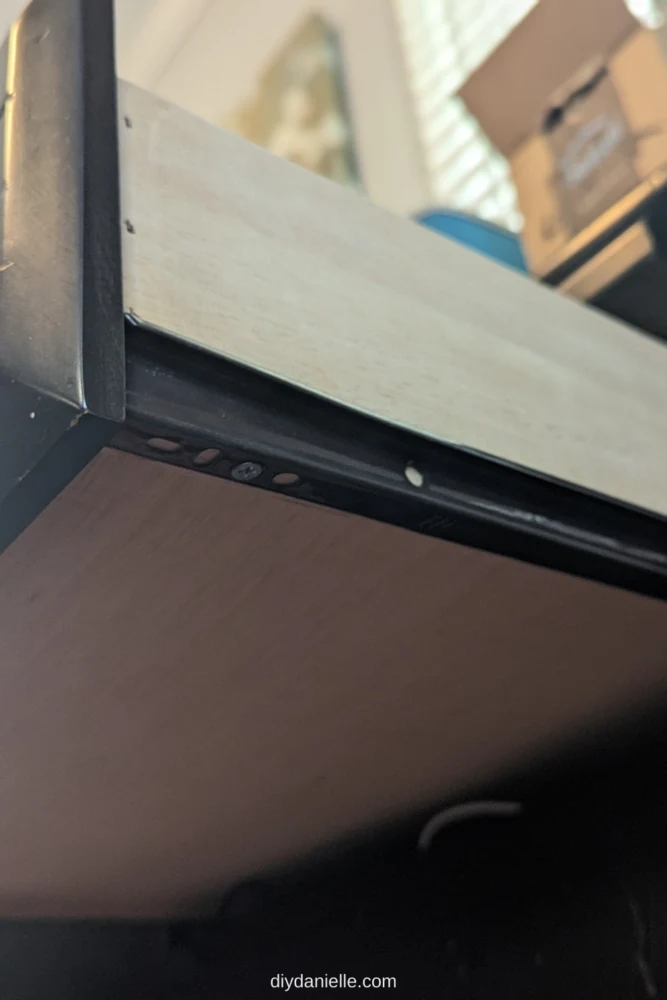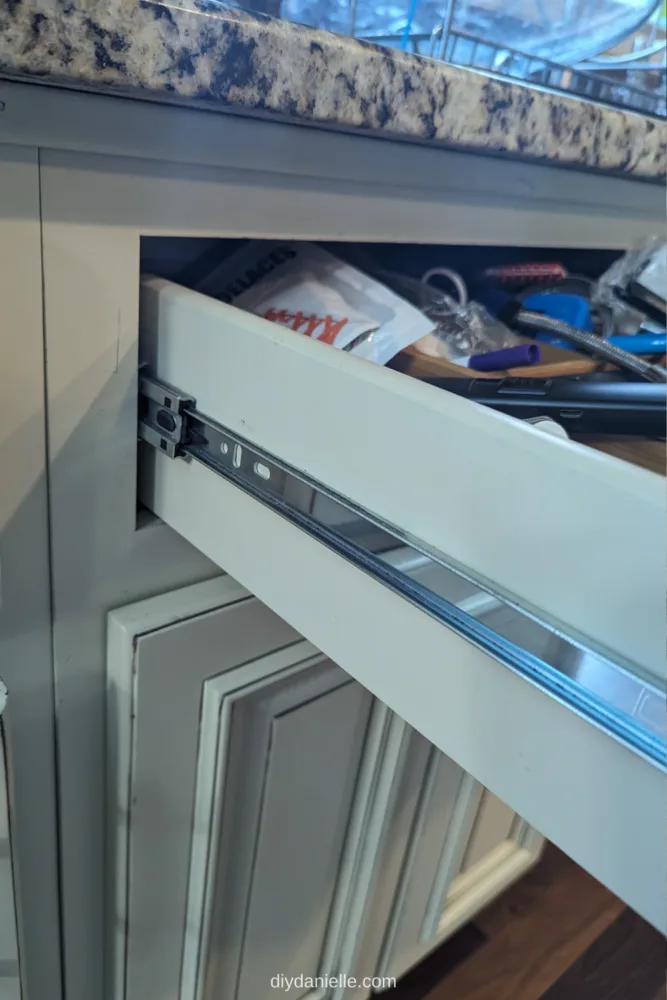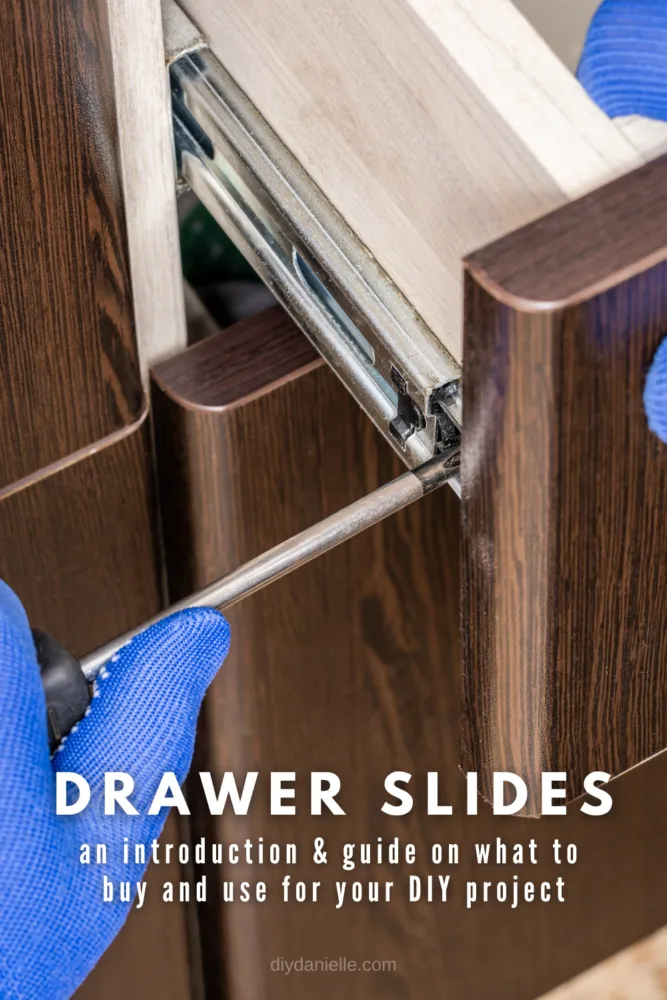Whether you’re DIY-ing drawer installation or consulting with a contractor, knowing the ins and outs of the different types of drawer slides can help you get the most out of the drawers around your home, achieving the look and function you have in mind. The type of slide you use also depends on what you plan on storing in your drawers.
This guide to drawer slides will give you insights on the types of drawer slides available, their advantages and disadvantages, types of extensions, and special features you may want on your drawers. Keep reading to learn more, and for a guide on installing drawers, check out my other post on how to install drawer slides.
This post may contain affiliate links which may earn me commissions should you click through them and take certain actions. As an affiliate for Amazon, Cricut, xTool, Home Depot, and other sites, I earn from qualifying purchases. Please DIY carefully. View my full legal disclosures here.
Please read the whole post so you don’t miss any important information!
Types of Drawer Slides
Center Mount Slides
Center mount slides usually rely on a single rail to support the drawer, but may also come with rollers that attach to the skeleton of the cabinet instead of the rail. This type of slide typically supports less weight than others, but are less expensive than other slides. Center mount slides are hidden when the drawer is pulled out and are easy to install, but they can easily come out of alignment over time or if they’re knocked around a bit.
Where they mount:
Like the name suggests, center mount slides mount in the center of the bottom of the drawer box underneath the drawer. May also require rollers mounted to the sides of the opening to help guide the drawer out.
Undermount Slides
Undermount slides are a little more expensive than center mount slides, but they can hold a lot of weight and are still fairly easy to install. They are not visible when drawer is open and make it easy to remove the drawer if necessary with a clip that can be unlocked from the track. They’re also adjustable. This type of mount is only available for drawers that have a recessed or captured bottom and only work with specific sizes of drawer boxes.
Where they mount:
Undermount slides are mounted to the sides and/or bottom of the drawer box.

Roller Slides
Roller slides rely on rolling wheels attached to the track, which allows the drawer to move back and forth almost seamlessly. This type of slide is affordable but can hold less weight than other types, and is prone to bend if the weight limit is exceeded. Roller slides also aren’t compatible with special features like soft-close or self-close. The rollers have to be painstakingly installed to be perfectly level to prevent the drawer from falling open on its own, and users find that they aren’t as durable as other types.
Where they mount:
Roller slides mount along the corners of the drawer.
Ball Bearing Slides
Ball bearing slides are really common, and use a ball bearing to roll the drawer along the track with low or virtually no friction, creating a smooth close. Ball bearing slides are installed in two pieces: one on the drawer and the other in the drawer box. They’re inexpensive, durable, easy to install, and have a high weight limit. They aren’t meant for areas where they can get really dirty, as dirt inside the track can cause the ball to stick or block it altogether. You can see the slides on the sides when the drawer is pulled out.
Where they mount:
Ball bearing slides are installed on the sides of the drawer.

Locking Drawer Slides
Locking drawer slides are mostly used in mobile situations where the drawers need to be prevented from opening in transit–think RVs, campers, work trucks, and tiny homes. They can also lock open to prevent the drawer from closing when you don’t want it to.
Where they mount:
Locking drawer slides mount on the sides or bottom of the drawer box.
Wooden Drawer Slides
Wooden drawer slides are built into the drawer itself, using grooves on the outside or underside of the drawer and a corresponding wooden rail on the inside of the drawer box that fit together and guide the drawer into place as you pull it out and push it into the drawer box.
They’re easy to diy, inexpensive, and can be made from scrap wood if you have extra laying around. They are visible when the drawer is pulled out, and can be tricky to close if the wood splits over time or if the specs aren’t precise enough. They need to be maintained with wax or oil regularly to keep the slide smooth, and they can expand and contract with the seasons like other wood furnishings. Drawers with wooden slides can come off the track, and are harder to adjust than some other types of slides.
Where they mount:
Wooden drawer slides mount on the sides or underneath the drawer. I have a picture of what I BELIEVE might be a drawer glide later on- but alternatively it might be considered a wooden drawer slide. I am not 100% sure.
Drawer Extensions
Drawer extensions come in different extension lengths (more on this later), and are available for several types of slides.
Drawer Glide vs. Drawer Slide
Is there a difference between a drawer glide and a drawer slide? Yep! Glides use rails on both the outside of the drawer and the drawer box, whereas glides can be mounted to just the drawer box.
I was trying to find ANY drawer in my house with a drawer glide… I’m not sure this qualifies, but it’s the best I could find. Most newer furniture seems to have the slides. They’re pretty easy to install and use.
The main picture below is how the bottom of the drawer looks and there is a piece of wood (it’s a bit broken on this drawer) that the drawer slides over.
The nested photo is how it looks from the bottom when the drawer is in place.

I’m guessing that due to these being more difficult to replace for people who don’t have the tools and aren’t handy, this method isn’t used as frequently anymore. This is a very old piece of furniture.
Soft-Close vs. Non-Soft-Close
Soft-close slides prevent drawers from closing harshly or slamming shut. Hardware on the slide catches the drawer as it’s being closed and slows it down to a gentle close. They close more quietly than non-soft-close drawers and prevent damage to the cabinet front.
Other Types of Closes
Self-Closing Slides
Self-closing drawer slides will roll the drawer back into place if you don’t shut it by hand all the way. Self-closing slides are great for drawers that get a lot of use or drawers in high-traffic areas that are frequently visible. The shut assistance typically only works if the drawer is pushed in past a certain point.
Push-to-Open Slides
Push-to-open slides work exactly as the name suggests: you push the drawer front and it pops itself open. These are typically more expensive than standard slides. Drawers with these types of slides don’t require pulls or handles.
Weight Limits
The weight limit for a drawer or drawer slide is typically known as the load rating. It’s important to pay close attention to the weight limit or load rating, as excessive weight can impede the functionality of the drawer slides and cause them to catch, sag, or bend.
Typical load ratings are 50, 75, 100, or 150 pounds of weight, but some slides can hold up to 500 pounds–just pay attention to the rating and keep the purpose of your drawer in mind when selecting slides and extensions.
What Size Drawer Slide Do I Need?
The size of drawer slide you’ll need to use depends on the depth of the drawer you’re outfitting. It’s important to choose a slide that matches the length of your drawer. A good rule of thumb is to make sure there’s about half an inch of space between the back of the drawer back of the drawer and the drawer box. Choosing a slide that’s too big won’t fit your drawer, and a slide that’s too small will prevent your drawer from opening all the way.
Extension Information
¾ Drawer Extensions
Three-quarter extensions will reveal most–but not all–of the inside of the drawer when it’s opened. This is considered a standard option and is typically cheaper than full extensions or over-travel extensions, but can cause issues if utensils or large items get jammed behind the close.
Full Drawer Extensions
Full drawer extensions allow the drawer to be pulled out to its full length. This kind of extension can be unstable if the weight limit is overloaded and may bend if the load is too heavy.
Over-Travel Drawer Extensions
An over-travel extension pulls out past the front of the box or cabinet, revealing the entire inside of the drawer. Over-travel extensions are ideal for drawers that hold long items that take up the entire length of the drawer or items with lids that need to be opened without removing them from the drawer.
Please share and pin this post! If you make this project, share it in our Stuff Mama Makes Facebook Group. We have regular giveaways for gift cards to craft stores. You can also tag me on Instagram @doityourselfdanielle; I love seeing everything you make!

